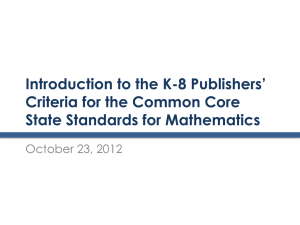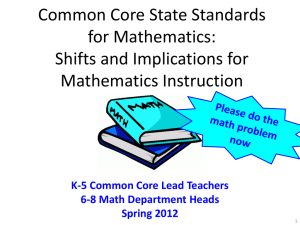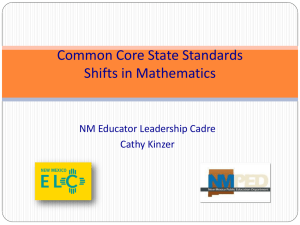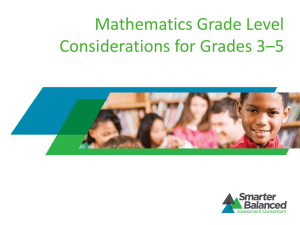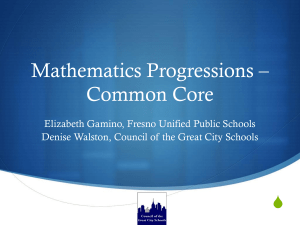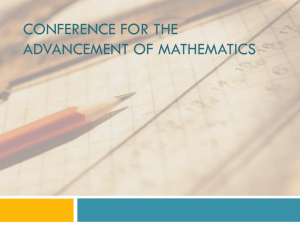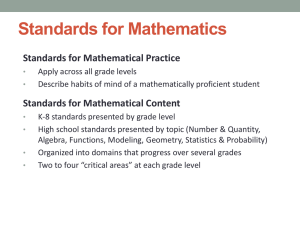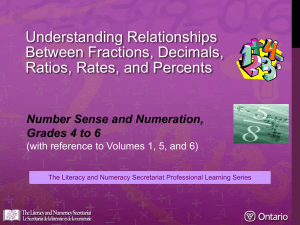Document
advertisement
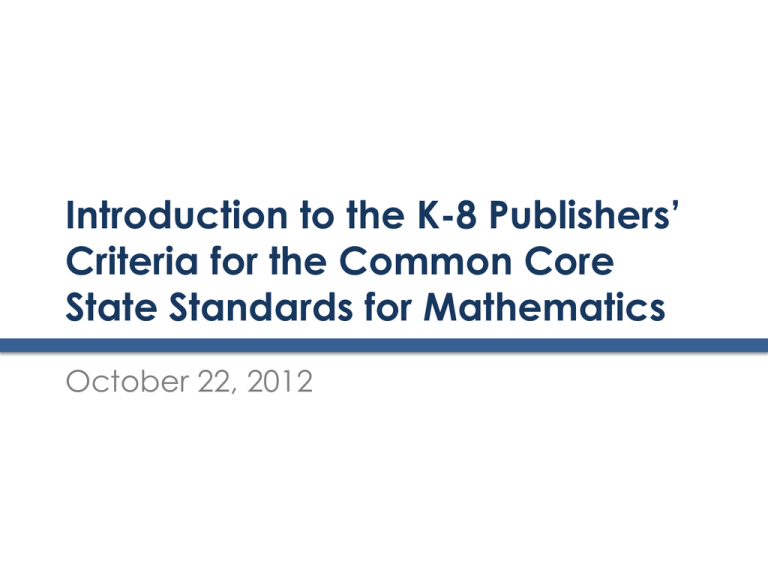
Introduction to the K-8 Publishers’ Criteria for the Common Core State Standards for Mathematics October 22, 2012 Agenda • • • Brief overview of the shifts required by the CCSS-M Walkthrough/discussion of Publishers’ Criteria Opportunity for questions 2 The Three Shifts • Focus strongly where the standards focus • Coherence: Think across grades and link to major topics within grades • Rigor: In major topics, pursue conceptual understanding, procedural skill and fluency, and application with equal intensity 3 Shift #1: Focus Strongly where the Standards Focus • Significantly narrow the scope of content and deepen how time and energy is spent in the math classroom. • Focus deeply on what is emphasized in the standards, so that students gain strong foundations. 4 Focus • Move away from "mile wide, inch deep" curricula identified in TIMSS. • • Learn from international comparisons. Teach less, learn more. “Less topic coverage can be associated with higher scores on those topics covered because students have more time to master the content that is taught.” – Ginsburg et al., 2005 5 The shape of math in A+ countries Mathematics topics intended at each grade by at least twothirds of A+ countries Mathematics topics intended at each grade by at least twothirds of 21 U.S. states 1 Schmidt, Houang, & Cogan, “A Coherent Curriculum: The Case of Mathematics.” (2002). 6 Traditional U.S. Approach K 12 Number and Operations Measurement and Geometry Algebra and Functions Statistics and Probability 7 Focusing Attention Within Number and Operations Operations and Algebraic Thinking Expressions → and Equations Number and Operations— Base Ten → K 1 2 3 4 Algebra The Number System Number and Operations— Fractions → → → 5 6 7 8 High School 8 Key Areas of Focus in Mathematics Grade Focus Areas in Support of Rich Instruction and Expectations of Fluency and Conceptual Understanding K–2 Addition and subtraction - concepts, skills, and problem solving and place value 3–5 Multiplication and division of whole numbers and fractions – concepts, skills, and problem solving 6 Ratios and proportional reasoning; early expressions and equations 7 Ratios and proportional reasoning; arithmetic of rational numbers 8 Linear algebra and linear functions 9 Shift #2: Coherence: Think Across Grades, and Link to Major Topics Within Grades • Carefully connect the learning within and across grades so that students can build new understanding on foundations built in previous years. • Begin to count on solid conceptual understanding of core content and build on it. Each standard is not a new event, but an extension of previous learning. 10 Coherence: Think Across Grades Example: Fractions “The coherence and sequential nature of mathematics dictate the foundational skills that are necessary for the learning of algebra. The most important foundational skill not presently developed appears to be proficiency with fractions (including decimals, percents, and negative fractions). The teaching of fractions must be acknowledged as critically important and improved before an increase in student achievement in algebra can be expected.” Final Report of the National Mathematics Advisory Panel (2008, p. 18) 11 CCSS Grade 4 Grade 5 4.NF.4. Apply and extend previous understandings of multiplication to multiply a fraction by a whole number. 5.NF.4. Apply and extend previous understandings of multiplication to multiply a fraction or whole number by a fraction. 5.NF.7. Apply and extend previous understandings of division to divide unit fractions by whole numbers and whole numbers by unit fractions. 6.NS. Apply and extend previous understandings of multiplication and division to divide fractions by fractions. Grade 6 Informing Grades 1-6 Mathematics Standards Development: What Can Be Learned from High-Performing Hong Kong, Singapore, and Korea? American Institutes for Research (2009, p. 13) 6.NS.1. Interpret and compute quotients of fractions, and solve word problems involving division of fractions by fractions, e.g., by using visual fraction models and equations to represent the problem. 12 Coherence: Link to Major Topics Within Grades Example: Data Representation Standard 3.MD.3 13 Coherence: Link to Major Topics Within Grades Example: Geometric Measurement 3.MD, third cluster 14 Shift #3: Rigor: In Major Topics, Pursue Conceptual Understanding, Procedural Skill and Fluency, and Application • The CCSSM require a balance of: Solid conceptual understanding Procedural skill and fluency Application of skills in problem solving situations • Pursuit of all threes requires equal intensity in time, activities, and resources. 15 Solid Conceptual Understanding • Teach more than “how to get the answer” and instead support students’ ability to access concepts from a number of perspectives • Students are able to see math as more than a set of mnemonics or discrete procedures • Conceptual understanding supports the other aspects of rigor (fluency and application) 16 17 18 Fluency • The standards require speed and accuracy in calculation. • Teachers structure class time and/or homework time for students to practice core functions such as singledigit multiplication so that they are more able to understand and manipulate more complex concepts 19 Required Fluencies in K-6 Grade Standard Required Fluency K K.OA.5 Add/subtract within 5 1 1.OA.6 Add/subtract within 10 2 2.OA.2 2.NBT.5 Add/subtract within 20 (know single-digit sums from memory) Add/subtract within 100 3 3.OA.7 3.NBT.2 Multiply/divide within 100 (know single-digit products from memory) Add/subtract within 1000 4 4.NBT.4 Add/subtract within 1,000,000 5 5.NBT.5 Multi-digit multiplication 6 6.NS.2,3 Multi-digit division Multi-digit decimal operations 20 Application • Students can use appropriate concepts and procedures for application even when not prompted to do so. • Teachers provide opportunities at all grade levels for students to apply math concepts in “real world” situations, recognizing this means different things in K-5, 6-8, and HS. • Teachers in content areas outside of math, particularly science, ensure that students are using grade-levelappropriate math to make meaning of and access science content. 21 Overview of the K-8 Publishers’ Criteria for Mathematics Available on www.corestandards.org/resources 22 Using the Criteria • As guidance for publishers • Informing purchases and adoptions, and/or • Working with previously purchased materials • Reviewing teacher-developed materials and guiding their development • As a tool for professional development 23 Supporting Innovation in Materials and Tools • CCSS presents a historic opportunity • Different forms of materials can meet the criteria • Workbooks • Targeted interventions • Multi-year programs • Digital materials offer substantial promise • Focus and coherence can be greatly enhanced through dynamic navigation 24 “These standards are not intended to be new names for old ways of doing business. They are a call to take the next step.” CCSSM, page 5 25 Some Old Ways of Doing Business (1 of 2) • A different topic every day • Every topic treated as equally important • Elementary students dipping into advanced topics at the expense of mastering fundamentals • Infinitesimal advance in each grade; endless review • Incoherence and illogic – bizarre associations, or lacking a thread 26 Some Old Ways of Doing Business (2 of 2) • Lack of rigor • Reliance on rote learning at expense of concepts • Aversion to repetitious practice • Severe restriction to stereotyped problems lending themselves to mnemonics or tricks From.... To…. 856 = ___ hundreds, ___ tens, ___ ones x2 – 10x + 21 = 0 1 hundredth = ___ tenths ¾ c(c –1) = c • Lack of quality applied problems and real-world contexts • Lack of variety in what students produce E.g., overwhelmingly only answers are produced, not arguments, diagrams, models, etc. 27 The Criteria do not replace the Standards 3/4 + 1/3 = ? 1/2 + 1/3 + 1/4 = ? 28 Supporting special populations “All students must have the opportunity to learn and meet the same high standards if they are to access the knowledge and skills necessary in their post-school lives. The Standards should be read as allowing for the widest possible range of students to participate fully from the outset, along with appropriate accommodations to ensure maximum participation of students with special education needs.” (CCSSM, p. 4) As stated in the Standards, an over-arching criterion for materials and tools is that they provide supports for special populations such as students with disabilities, English language learners, and gifted students. 29 #1. Focus on Major Work In any single grade, students and teachers using the materials as designed spend the large majority of their time, approximately three-quarters,* on the major work of each grade. • Major work should especially predominate at the beginning of the year. • Especially careful treatment of the clusters leading to algebra (and their interconnections) * Approx. 2/3 in grade 7 30 Progress to Algebra in Grades K-8 31 #2. Focus in Early Grades Materials do not assess any of the following topics before the grade level indicated. Topic Grade Introduced Probability, including chance, likely outcomes, probability models. 7 Statistical distributions, including center, variation, clumping, outliers, mean, median, mode, range, quartiles, and statistical association or trends, including two-way tables, bivariate measurement data, scatter plots, trend line, line of best fit, correlation. 6 Similarity, congruence, or geometric transformations. 8 Symmetry of shapes, including line/reflection symmetry, rotational symmetry. 4 Additionally, materials do not assess pattern problems in K-5 that do not support the focus on arithmetic, such as “find the next one” problems. 32 #3. Focus and Coherence through Supporting Work Supporting content does not detract from focus, but rather enhances focus and coherence simultaneously by engaging students in the major work of the grade. 33 #4. Rigor and Balance Materials and tools reflect the balances in the Standards and help students meet the Standards’ rigorous expectations, by: a) Developing students’ conceptual understanding of key mathematical concepts, where called for in specific content standards or cluster headings b) Giving attention throughout the year to individual standards that set an expectation of fluency. c) Allowing teachers and students using the materials as designed to spend sufficient time working with engaging applications, without losing focus on the major work of each grade. 34 Additional Aspects of the Rigor and Balance Criterion 1) The three aspects of rigor are not always separate in materials. 2) Nor are the three aspects of rigor always together in materials. • Digital and online materials with no fixed lesson flow or pacing plan are not designed for superficial browsing but rather instantiate the Rigor and Balance criterion and promote depth and mastery. 35 #5. Consistent Progressions Materials are consistent with the progressions in the Standards, by (all of the following): a) Basing content progressions on the grade-by-grade progressions in the Standards. b) Giving all students extensive work with grade-level problems. c) Relating grade-level concepts explicitly to prior knowledge from earlier grades. 36 #6. Coherent Connections Materials foster coherence through connections at a single grade, where appropriate and where required by the Standards, by (all of the following): a) Including learning objectives that are visibly shaped by CCSSM cluster headings, with meaningful consequences for the associated problems and activities. b) Including problems and activities that serve to connect two or more clusters in a domain, or two or more domains in a grade, in cases where these connections are natural and important. 37 #7. Practice-Content Connections Materials meaningfully connect content standards and practice standards. “Designers of curricula, assessments, and professional development should all attend to the need to connect the mathematical practices to mathematical content in mathematics instruction.” (CCSSM, p. 8.) 38 #7. Practice-Content Connections What does it look like for materials to meaningfully connect content and practice standards? (1 of 2) • Over the course of any given year of instruction, each mathematical practice standard is meaningfully present and well-grounded in the content standards. • Materials are accompanied by an analysis, aimed at evaluators, of how the authors have approached each practice standard in relation to content within each applicable grade or grade band. 39 #7. Practice-Content Connections What does it look like for materials to meaningfully connect content and practice standards? (2 of 2) • Materials do not treat the practice standards as static across grades or grade bands, but instead tailor the connections to the content of the grade and to grade-level-appropriate student thinking. • Materials also include teacher-directed materials that explain the role of the practice standards in the classroom and in students’ mathematical development. 40 #8. Focus and Coherence via Practice Standards Materials promote focus and coherence by connecting practice standards with content that is emphasized in the Standards. • Content and practice standards are not connected mechanistically or randomly, but instead support focus and coherence. For example: • Materials connect looking for and making use of structure (MP.7) with structural themes emphasized in the standards such as properties of operations, place value decompositions of numbers, numerators and denominators of fractions, numerical and algebraic expressions, etc. 41 #8. Focus and Coherence via Practice Standards • Materials connect looking for and expressing regularity in repeated reasoning (MP.8) with major topics by using regularity in repetitive reasoning as a tool with which to explore major topics. • In K-5, shed light on, e.g., the 10 x 10 addition table, the 10 x 10 multiplication table, the properties of operations, the relationship between addition and subtraction or multiplication and division, and the place value system; • in 6-8, materials shed light on proportional relationships and linear functions; • in high school, materials shed light on formal algebra as well as functions, particularly recursive definitions of functions. 42 #9. Careful attention to Each Practice Standard Materials attend to the full meaning of each practice standard. A few examples (1 of 3) • • MP.1 does not say, “Solve problems.” Or “Make sense of problems.” Or “Make sense of problems and solve them.” It says “Make sense of problems and persevere in solving them.” Thus, students using the materials as designed build their perseverance in grade-level-appropriate ways by occasionally solving problems that require them to persevere to a solution beyond the point when they would like to give up. 43 #9. Careful attention to Each Practice Standard Materials attend to the full meaning of each practice standard. A few examples (2 of 3) • • MP.5 does not say, “Use tools.” Or “Use appropriate tools.” It says “Use appropriate tools strategically.” Thus, materials include problems that reward students’ strategic decisions about how to use tools, or about whether to use them at all. 44 #9. Careful attention to Each Practice Standard Materials attend to the full meaning of each practice standard. A few examples (3 of 3) • • MP.8 does not say, “Extend patterns.” Or “Engage in repetitive reasoning.” It says “Look for and express regularity in repeated reasoning.” Thus, it is not enough for students to extend patterns or perform repeated calculations. Those repeated calculations must lead to an insight (e.g., “When I add a multiple of 3 to another multiple of 3, then I get a multiple of 3.”). 45 #10. Emphasis on Mathematical Reasoning Materials support the Standards’ emphasis on mathematical reasoning, by (all of the following): a) Prompting students to construct viable arguments and critique the arguments of others concerning key grade-level mathematics that is detailed in the content standards (cf. MP.3). b) Engaging students in problem solving as a form of argument. c) Explicitly attending to the specialized language of mathematics. 46 Indicators of Quality (1 of 2) • • • • Problems are worth doing Variety in what students produce Variety in the pacing and grain size of content coverage Separate teacher materials that support and reward teacher study • Use of manipulatives follows best practices • Materials are carefully reviewed (freedom from mathematical errors, grade-level appropriateness, freedom from bias, freedom from construct-irrelevant language complexity) 47 Indicators of Quality (2 of 2) • Visual design isn’t distracting, chaotic, aimed at adult purchasers – serves only to support young students in engaging thoughtfully with the subject • Support for English language learners is thoughtful and helps those learners to meet the same standards as all other students • (For paper-based materials.) A textbook that is focused is short. For example, by design Japanese textbooks have less than one page per lesson. Elementary textbooks should be less than 200 pages, middle and secondary less than 500 pages 48 K-8 Publishers’ Criteria for Mathematics: Next Steps for Educators/Policy-makers Use Cases What States, Districts and Teachers Can Do Informing purchases and adoptions Ensure that instructional resource purchasing criteria and decisions are aligned to the Publishers’ Criteria. Working with previously purchased materials Use the Publishers’ Criteria to review existing materials and adjust to improve alignment (remove or supplement). Reviewing teacherdeveloped materials and guiding their development Use the Publishers’ Criteria to support teachers in developing materials and ensure that teacherdeveloped resources are aligned. As a tool for professional development Share the Publishers’ Criteria with teachers and use it to support teacher understanding of the standards. For additional resources for educators, go to achievethecore.org. 49 Questions? 50
